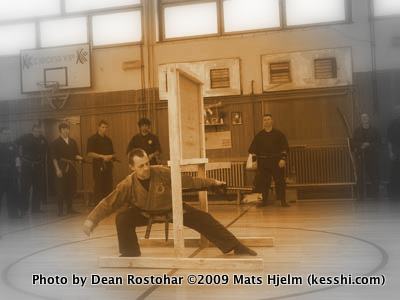From Kabutoshimen by Toryu
I think most of you have heard about the 45° step when you do the basic jodan-uke for example, this does not mean that you end up in a 45° angle to the attack that I so often see. I think this is a misunderstanding, and I will explain here so that you have to be an idiot if you don’t understand  .
.
But first let’s make some reference points. To get the distance right we need to understand that the opponent will hit you in the head with his right fist. And that you want to end up at a safe distance where you can block the opponent’s right arm from the inside without being to close or too far away. So you need to move your whole body as one unit about one arms length. So measure how far that is. I will use the tatami mat as a reference point so that you can easily understand. I recommend that you also use the tatami mat as I do here so that you can do the step without looking. And then look down and check if you are on the correct spot, angles and length wise.
Remember that you move the body one arm’s length, it doesn’t matter how long the opponent’s arms is. If he knows how deep he should punch (just through the target and not an inch more!) it will be perfect distance for you.

When you move from point A to point B in the first step you should have the exact same angles but one arms length further back to the side. You should have rotated the whole body about 30° to the left, but the angles and alignment should be the same.

So when you start in the basic Ichimonji no kamae both heel’s should be on the same line and pointing directly against the opponent’s center. I won’t go into detail about anything else than the footwork here. I might do a part two of this tutorial later?

The right foot and toes should be pointing exactly 45° back to the right against the other corner of the tatami mat. Keep a rather low position with both knees bent (in basic training, be extra low), more weight on the right leg.

Lift the right foot and push the body strongly and quickly back to the right with the left foot. You should explode from the position, so make sure the front leg is not too straight. Do not move the left foot first (I say that this is a bad habit). If you keep your right arm straight against the opponent, he will not step on the left foot, as he have to move around your arm.

The right foot should go exactly 45° towards the corner of the tatami. Note how the right foot have turned a little, but the heel should be on the line. At the same time the left foot should follow the right foot in a straight line.

As you can see this angle is about 30° from the starting point. Also worth mentioning is that the feet’s is never this wide apart as it is rather a jump than step, step. It is important that the upper body should not go anywhere else but straight backwards to the side as if you where on wheels.

See how the left foot ends up on the same line. Now you have moved the body 30° back to the right. You should end up in the exact same position as when you started. Your kamae is “closed” and good, aimed directly to the opponents inside.

From here you block and take his balance… as you can see you have also opened up the opponent’s lower region. You have the opening where you will place the right foot as you step in and counter with your own attack.
Training drill
A very good training drill is to stand in Ichimonji no kamae and move from point A to point B as explained above. Repeat this several times, you should move in a big circle keeping a perfect Ichimonji no kamae the whole time. Then change side and do it to the left. This is a good exercise that strenghten your legs and gives you a good foundation.
Happy training!
/Mats…

 In September 2009
In September 2009  As always Dean teach from his big heart, you who have been to his trainings know what I mean. The first day he did techniques based on the first technique Ichimonji from Kihon happo kata. But it was different than what he showed before, more realistic and useful. Although he never said that the basics is bad to know or practice, but the basics is basics to teach students a foundation to build up on. When you know the basics well you combine each basic movement to the situation, and it comes alive. You do what you have to do to benefit from the situation. He showed many different taijutsu techniques this weekend.
As always Dean teach from his big heart, you who have been to his trainings know what I mean. The first day he did techniques based on the first technique Ichimonji from Kihon happo kata. But it was different than what he showed before, more realistic and useful. Although he never said that the basics is bad to know or practice, but the basics is basics to teach students a foundation to build up on. When you know the basics well you combine each basic movement to the situation, and it comes alive. You do what you have to do to benefit from the situation. He showed many different taijutsu techniques this weekend. The
The 


























